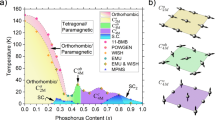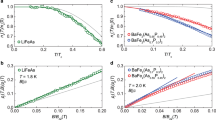Abstract
Elucidating the nature of the magnetic ground state of iron-based superconductors is of paramount importance in unveiling the mechanism behind their high-temperature superconductivity. Until recently, it was thought that superconductivity emerges only from an orthorhombic antiferromagnetic stripe phase, which can in principle be described in terms of either localized or itinerant spins. However, we recently reported that tetragonal symmetry is restored inside the magnetically ordered state of certain hole-doped compounds, revealing the existence of a new magnetic phase at compositions close to the onset of superconductivity. Here, we present Mössbauer data that show that half of the iron sites in this tetragonal phase are non-magnetic, establishing conclusively the existence of a novel magnetic ground state with a non-uniform magnetization that is inconsistent with localized spins. Instead, this state is naturally explained as the interference between two commensurate spin-density waves, a rare example of collinear double-Q magnetic order. Our results demonstrate the itinerant character of the magnetism of the iron pnictides, and the primary role played by magnetic degrees of freedom in determining their phase diagram.
This is a preview of subscription content, access via your institution
Access options
Subscribe to this journal
Receive 12 print issues and online access
$209.00 per year
only $17.42 per issue
Buy this article
- Purchase on Springer Link
- Instant access to full article PDF
Prices may be subject to local taxes which are calculated during checkout



Similar content being viewed by others
References
Slater, J. C. Ferromagnetism and the band theory. Rev. Mod. Phys. 25, 199–210 (1953).
Van Vleck, J. H. Models of exchange coupling in ferromagnetic media. Rev. Mod. Phys. 25, 220–227 (1953).
Herring, C. in Magnetism (eds Rado, G. T. & Suhl, H.) Vol. IV (Academic, 1966).
Moriya, T. & Takahashi, Y. Itinerant electron magnetism. Annu. Rev. Mater. Sci. 14, 1–25 (1984).
Chubukov, A. V. Pairing mechanism in Fe-based superconductors. Annu. Rev. Condens. Matter Phys. 3, 57–92 (2012).
Hirschfeld, P. J., Korshunov, M. M. & Mazin, I. I. Gap symmetry and structure of Fe-based superconductors. Rep. Prog. Phys. 74, 124508 (2011).
Si, Q. & Abrahams, E. Strong correlations and magnetic frustration in the high Tc iron pnictides. Phys. Rev. Lett. 101, 076401 (2008).
Seo, K., Bernevig, B. A. & Hu, J. Pairing symmetry in a two-orbital exchange coupling model of oxypnictides. Phys. Rev. Lett. 101, 206404 (2008).
de’ Medici, L., Giovannetti, G. & Capone, M. Selective Mott physics as a key to iron superconductors. Phys. Rev. Lett. 112, 177001 (2014).
Krüger, F., Kumar, S., Zaanen, J. & van den Brink, J. Spin-orbital frustrations and anomalous metallic state in iron-pnictide superconductors. Phys. Rev. B 79, 054504 (2009).
Kontani, H., Inoue, Y., Saito, T., Yamakawa, Y. & Onari, S. Orbital fluctuation theory in iron-based superconductors: s++-wave superconductivity, structure transition, and impurity-induced nematic order. Solid State Commun. 152, 718–727 (2012).
Chubukov, A. V., Efremov, D. V. & Eremin, I. Magnetism, superconductivity, and pairing symmetry in iron-based superconductors. Phys. Rev. B 78, 134512 (2008).
Cvetkovic, V. & Tešanović, Z. Multiband magnetism and superconductivity in Fe-based compounds. Europhys. Lett. 85, 37002 (2009).
Fernandes, R. M. et al. Unconventional pairing in the iron arsenide superconductors. Phys. Rev. B 81, 140501 (2010).
Fernandes, R. M., Chubukov, A. V. & Schmalian, J. What drives nematic order in iron-based superconductors? Nature Phys. 10, 97–104 (2014).
Johannes, M. & Mazin, I. Microscopic origin of magnetism and magnetic interactions in ferropnictides. Phys. Rev. B 79, 220510 (2009).
Hansmann, P. et al. Dichotomy between large local and small ordered magnetic moments in iron-based superconductors. Phys. Rev. Lett. 104, 197002 (2010).
Yin, W.-G., Lee, C.-C. & Ku, W. Unified picture for magnetic correlations in iron-based superconductors. Phys. Rev. Lett. 105, 107004 (2010).
Yin, Z. P., Haule, K. & Kotliar, G. Kinetic frustration and the nature of the magnetic and paramagnetic states in iron pnictides and iron chalcogenides. Nature Mater. 10, 932–935 (2011).
Bascones, E., Valenzuela, B. & Calderón, M. J. Orbital differentiation and the role of orbital ordering in the magnetic state of Fe superconductors. Phys. Rev. B 86, 174508 (2012).
Dai, P., Hu, J. & Dagotto, E. Magnetism and its microscopic origin in iron-based high-temperature superconductors. Nature Phys. 8, 709–718 (2012).
Avci, S. et al. Structural, magnetic, and superconducting properties of Ba1−xNaxFe2As2 . Phys. Rev. B 88, 094510 (2013).
Avci, S. et al. Magnetically driven suppression of nematic order in an iron-based superconductor. Nature Commun. 5, 3845 (2014).
Yu, R., Goswami, P., Si, Q., Nikolic, P. & Zhu, J.-X. Superconductivity at the border of electron localization and itinerancy. Nature Commun. 4, 2783 (2013).
Böhmer, A. E. et al. Superconductivity-induced re-entrance of the orthorhombic distortion in Ba1−xKxFe2As2 . Nature Commun. 6, 7911 (2015).
Allred, J. M. et al. Tetragonal magnetic phase in Ba1−xKxFe2As2 from X-ray and neutron diffraction. Phys. Rev. B 92, 094515 (2015).
Hassinger, E. et al. Pressure-induced Fermi-surface reconstruction in the iron-arsenide superconductor Ba1−xKxFe2As2: evidence of a phase transition inside the antiferromagnetic phase. Phys. Rev. B 86, 140502 (2012).
Khalyavin, D. D. et al. Symmetry of reentrant tetragonal phase in Ba1−xNaxFe2As2: magnetic versus orbital ordering mechanism. Phys. Rev. B 90, 174511 (2014).
Giovannetti, G. et al. Proximity of iron pnictide superconductors to a quantum tricritical point. Nature Commun. 2, 398 (2011).
Eremin, I. & Chubukov, A. V. Magnetic degeneracy and hidden metallicity of the spin-density-wave state in ferropnictides. Phys. Rev. B 81, 024511 (2010).
Brydon, P. M. R., Schmiedt, J. & Timm, C. Microscopically derived Ginzburg-Landau theory for magnetic order in the iron pnictides. Phys. Rev. B 84, 214510 (2011).
Wang, X., Kang, J. & Fernandes, R. M. Magnetic order without tetragonal-symmetry-breaking in iron arsenides: microscopic mechanism and spin-wave spectrum. Phys. Rev. B 91, 024401 (2015).
Gastiasoro, M. N. & Andersen, B. M. Competing magnetic double-Q phases and superconductivity-induced re-entrance of C2 magnetic stripe order in iron pnictides. Phys. Rev. B 92, 140506 (2015).
Fernandes, R. M., Kivelson, S. A. & Berg, E. Is there a hidden chiral density-wave in the iron-based superconductors? Preprint at http://arXiv.org/abs/1504.03656 (2015).
Waßer, F. et al. Spin reorientation in Ba0.65Na0.35Fe2As2 studied by single-crystal neutron diffraction. Phys. Rev. B 91, 060505 (2015).
Jo, T. On the possibility of the multiple spin density wave state in the first-kind antiferromagnetic FCC metals. J. Phys. F 13, L211–L216 (1983).
Long, M. W. Effects that can stabilise multiple spin-density waves. J. Phys. Condens. Matter 1, 2857–2874 (1989).
Fishman, R. S. et al. Structural and magnetic phase transitions in Mn–Ni alloys. Phys. Rev. B 61, 12159–12168 (2000).
Cortes-Gil, R. & Clarke, S. J. Structure, magnetism, and superconductivity of the layered iron arsenides Sr1−xNaxFe2As2 . Chem. Mater. 23, 1009–1016 (2011).
McGuire, M. A. et al. Phase transitions in LaFeAsO: structural, magnetic, elastic, and transport properties, heat capacity and Mössbauer spectra. Phys. Rev. B 78, 094517 (2008).
Kitao, S. et al. Spin ordering in LaFeAsO and its suppression in superconductor LaFeAsO0.89F0.11 probed by Mössbauer spectroscopy. J. Phys. Soc. Jpn 77, 103706 (2008).
Fernandes, R. M., Chubukov, A. V., Knolle, J., Eremin, I. & Schmalian, J. Preemptive nematic order, pseudogap, and orbital order in the iron pnictides. Phys. Rev. B 85, 024534 (2012).
Lv, W., Wu, J. & Phillips, P. W. Orbital ordering induces structural phase transition and the resistivity anomaly in iron pnictides. Phys. Rev. B 80, 224506 (2009).
Yu, R., Zhu, J.-X. & Si, Q. Orbital-selective superconductivity, gap anisotropy, and spin resonance excitations in a multiorbital t-J1-J2 model for iron pnictides. Phys. Rev. B 89, 024509 (2014).
Cvetkovic, V. & Vafek, O. Space group symmetry, spin–orbit coupling, and the low-energy effective Hamiltonian for iron-based superconductors. Phys. Rev. B 88, 134510 (2013).
Borisenko, S. V. et al. Direct observation of spin–orbit coupling in iron-based superconductors. Nature Phys. http://dx.doi.org/10.1038/nphys3594 (2015).
Christensen, M. H., Kang, J., Andersen, B. M., Eremin, I. & Fernandes, R. M. Spin reorientation driven by the interplay between spin–orbit coupling and Hund’s rule coupling in iron pnictides. Phys. Rev. B 92, 214509 (2015).
Acknowledgements
Work at Argonne (J.M.A., K.M.T., D.E.Bugaris, M.J.K., D.Y.C., H.C., M.G.K., S.R., O.C. and R.O.) was supported by the US Department of Energy, Office of Science, Materials Science and Engineering Division. X-ray experiments were performed at the Advanced Photon Source, which is supported by the Office of Basic Energy Sciences under Contract No. DE-AC02-06CH11357. Neutron experiments were performed at the High Flux Isotope Reactor and Spallation Neutron Source. R.M.F. and J.K. were supported by the US Department of Energy, Office of Science, Basic Energy Sciences, under award number DE-SC0012336. The work of I.E. was supported by the Focus Program 1458 Eisen-Pniktide of the DFG, and by the German Academic Exchange Service (DAAD PPP USA no. 57051534). I.E. also acknowledges the financial support of the Ministry of Education and Science of the Russian Federation in the framework of Increase Competitiveness Program of NUST MISiS (N 22014015). The authors thank A. A. Aczel, A. Huq, M. J. Kirkham and P. S. Whitfield for experimental assistance, E. E. Alp for use of his Mössbauer spectrometer, and B. M. Andersen, A. V. Chubukov, M. N. Gastiasoro, A. Yaresko and Y. Zhao for fruitful discussions.
Author information
Authors and Affiliations
Contributions
Samples were prepared by D.E.Bugaris, with additional support from D.Y.C., and M.G.K. The experiments were devised by J.M.A., K.M.T., O.C., S.R. and R.O. The X-ray and neutron diffraction experiments were performed by J.M.A., K.M.T., O.C., M.J.K., S.R. and S.H.L. Mössbauer spectroscopy was performed by D.E.Brown Magnetization measurements were performed by H.C. The data were analysed by J.M.A., K.M.T., O.C., S.R., R.O. and D.E.Brown. Theoretical interpretation was provided by J.K., R.M.F. and I.E. The manuscript and Supplementary Information were written by J.M.A., R.O., R.M.F. and I.E. with input from all the authors.
Corresponding author
Ethics declarations
Competing interests
The authors declare no competing financial interests.
Supplementary information
Supplementary information
Supplementary information (PDF 895 kb)
Rights and permissions
About this article
Cite this article
Allred, J., Taddei, K., Bugaris, D. et al. Double-Q spin-density wave in iron arsenide superconductors. Nature Phys 12, 493–498 (2016). https://doi.org/10.1038/nphys3629
Received:
Accepted:
Published:
Issue Date:
DOI: https://doi.org/10.1038/nphys3629
This article is cited by
-
Charge order driven by multiple-Q spin fluctuations in heavily electron-doped iron selenide superconductors
Nature Communications (2023)
-
Multiple magnetic orders in LaFeAs1-xPxO uncover universality of iron-pnictide superconductors
Communications Physics (2022)
-
Iron pnictides and chalcogenides: a new paradigm for superconductivity
Nature (2022)
-
57Fe and 151Eu Mössbauer studies of 3d-4f spin interplay in EuFe2−xNixAs2
Scientific Reports (2021)
-
Pressure induced superconductivity in MnSe
Nature Communications (2021)



